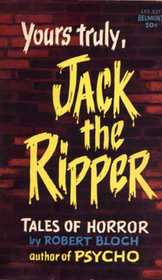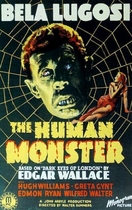Our editor-in-chief Nate Yapp is proud to have contributed to the new book Hidden Horror: A Celebration of 101 Underrated and Overlooked Fright Flicks, edited by Aaron Christensen. Another contributors include Anthony Timpone, B.J. Colangelo, Dave Alexander, Classic-Horror.com's own Robert C. Ring and John W. Bowen. Pick up a copy today from Amazon.com!
Cold Reads: Yours Truly, Jack the Ripper by Robert Bloch
More so than perhaps any other serial killer in history, Jack the Ripper has been molded into a figure of almost mythical proportions over the years since his gruesome crime spree. This may be because he was never apprehended by the law and, most importantly, that he was never given a human face for the public to identify him with. This has distorted an already warped soul into something greater, a demonic creature whose existence still remains a mystery. Robert Bloch, a literary mastermind who knows how to craft a fine psychopath, offers up his own serving of Red Jack on a bloody platter.
Psychiatrist John Carmody is met in his Chicago office one afternoon by the eccentric Sir Guy Hollis. The English actor wishes to inform the good doctor of a theory he has been developing concerning one London serial killer. Through decades of research and his own personal studies, Hollis has concluded that the Ripper is alive and well, living currently in the Windy City no less! According to Hollis, Jack the Ripper is dealing in sorcery, his youth a result of the sacrifices (disguised as murders) he offers to the gods of darkness. Hollis has been following the Ripper all across the globe for his whole life, never being able to capture the murderer before his astrologically-timed killing sprees. Now finally cornering him in the city's underbelly, Hollis takes Carmody along with him on a journey to end the reign of the one that got away.
If there's one thing Bloch knows how to do well, it's sucking the reader in with an engaging storyline and enjoyable characters to boot. The plot is fascinating to say the least, and seems to be a head on collision of Bloch's early days penning supernatural tales for the shudder pulps and the deeply psychological tales of his later career. It's a mixture of two distinct and terrifying evils; one of them that of the mystic, ghost-laden realm of the dark while the other is the equally shadowy and unknown human soul. Jack the Ripper seems to be the appropriate conduit to deal with these two separate entities, a killer whose background is shrouded in perplexing strangeness but whose crimes are grounded in harsh, cold reality.
Distinction between these two realms seems to blur in the story, each one entering and melting into the next. This theme of uncertainty and vagueness is used throughout the tale. Carmody is at odds with what to do about Hollis. Does he go along with his little game, even if it means the endangerment of innocent lives? Though he may be a knowledgeable psychiatrist, Carmody is always debating Hollis's sanity and motives. He is uncertain if Hollis is just some crazed psychopath, much like the one he's hunting. But that feeling of insecurity keeps poking at Carmody's brain. Hollis's theory is irrational, to put it lightly. This is present day Chicago, he seems to be saying. There are no black magic murderers causing mayhem in the streets. But what if Hollis is right...? The distinction between reality and horror is shattered with this question, and the monsters from both worlds begin to break free.
To accentuate this theme of being lost in a mental haze, Bloch uses powerful images such as the city fog and the darkness of the night to drive his point home. These two devices are used in key scenes of the story, the first one being a party that Carmody takes Hollis to in order to detect the Ripper. Lester, the head of the shenanigans, decides to make the evening more interesting after hearing Hollis's theory. Lester proposes to turn off the lights so that any of the party attendees who may be Jack the Ripper may make themselves known. The accused can do this either by making their escape or taking the chance to snuff out their pursuer.
As soon as the lights go out, the tension builds like a surging locomotive beginning its ride. Through the thoughts of Carmody, we find out just how terrifying the dark truly is. Carmody says that everyone's identity is lost in darkness, that people lose the social masks they work so hard to uphold in the light. Everyone just becomes bodies, equal in fear and lack of distinction. And, worst of all, that monsters use the cloak of darkness to walk freely. Within the shadows, they can strike at their prey, unseen, without them even being aware of their presence. Carmody dismally ruminates that the Ripper used to work in such darkness and the fact that a madman could be present in the very same room is a genuinely terrifying thought. Anything is possible in the dark. Dreams... and nightmares.
This primal fear of the invisible is utilized again when Carmody and Hollis are walking through the chilly streets of the slums, the midnight fog constricting their vision to near blindness. Whereas during the party everyone was entrapped in a single space of blackness, the misty streets provide a wide, open environment that is nevertheless blocked from human sight. The sadistic thing is that this gives us the feeling that now there are hundreds of more possibilities as to just when, where, and how the monsters will decide to attack. The Ripper is one of these monsters and he's out on the prowl. And though you may not be able to see him, he can most certainly see you. Bloch plays the paranoia of the reader like a song, making them feel as if there is a pair of glowing eyes watching them as well. If you read this story before taking an evening stroll, be prepared to throw more than a few backward glances over your shoulder.
Sandwiched between all this gloominess are a few of Bloch's trademarks, one of them being his wicked sense of humor. He revels in describing the exaggerated drunkenness of the party members to the point of laugh-out-loud hilarity. There is one riotous moment where Lester decides to call everyone's attention by the conventional manner of smashing a vase on the ground. Bloch also sneaks in a few good puns that Lester uses to describe what a ripping good time Red Jack used to have in his homicidal heydays. Hardy har har. Humor is an effective tool that, when in the hands of a genius writer, can inject the story with new life that only increases the reader's enjoyability instead of distracting them from the content of the tale. Robert Bloch is indeed one of those genius writers.
For those who know that Bloch was also the author of the legendary Psycho, a twist ending would seem to be expected from this story as well. This is another department that the writer always succeeds in. The ending comes so suddenly and yet so smoothly that the reader may have to reread it a few times just to let it sink in. Of course, I'm not going to be the one to divulge the big reveal to those of you who are eager to know. I will leave the telling of this little secret up to the master. You will be doing yourself a great injustice if you do not read this story immediately after finishing this review. Hurry down to your nearest dusty bookshop to find an anthology that carries this tale. If you happen to hear some footsteps following you down the street, it's probably best to ignore them. Just try to avoid those lonesome alleyways.









i want to read
i want to read
After attending a Jack the
After attending a Jack the Ripper tour last summer, I became more interested in the Ripper's story. This book sound intriguing and I'll definitely try to read it over the weekend.